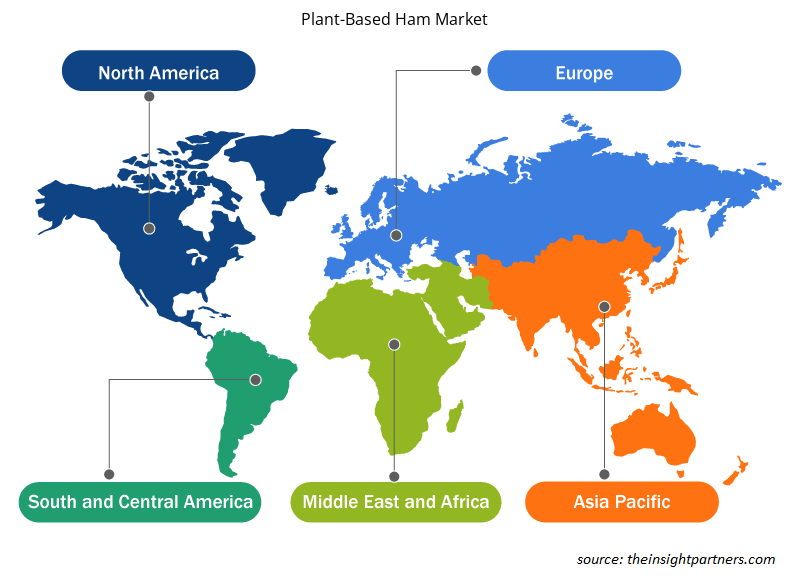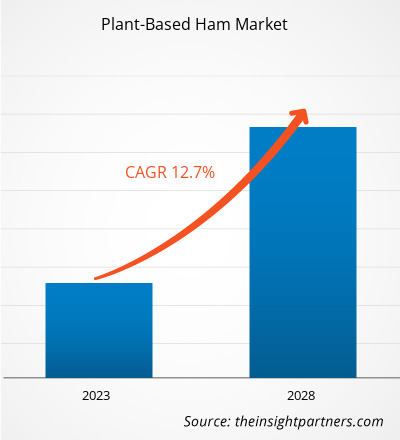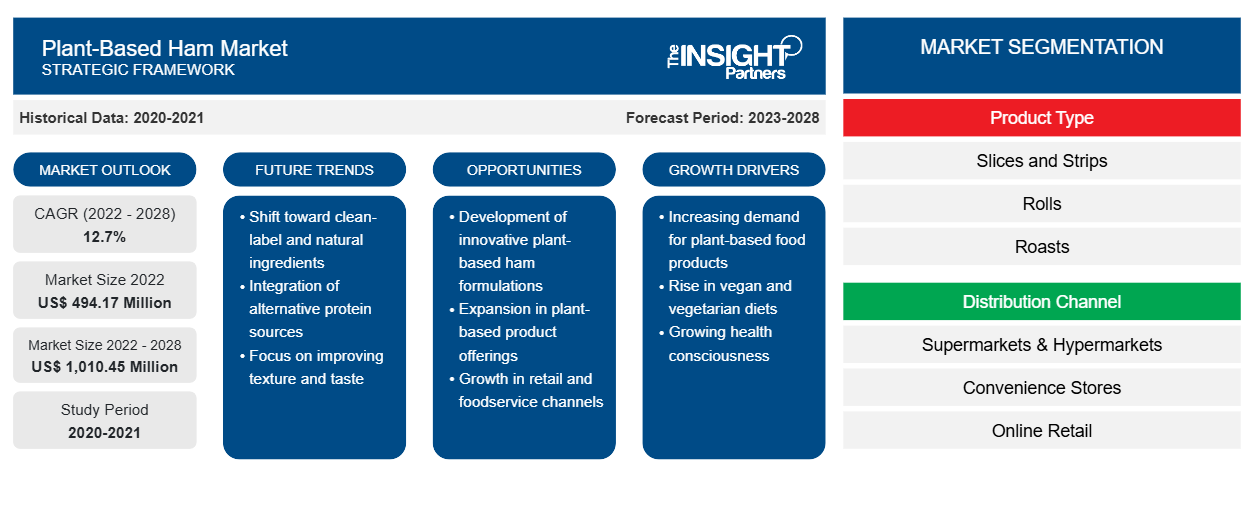La taille du marché du jambon à base de plantes devrait passer de 494,17 millions de dollars américains en 2022 à 1 010,45 millions de dollars américains en 2028 ; elle devrait croître à un TCAC de 12,7 % de 2022 à 2028.
Les consommateurs se tournent rapidement vers les produits à base de viande végétale en raison de la prise de conscience croissante des effets négatifs de la consommation de viande et de l'industrie de l'élevage sur l'environnement, ainsi que des effets néfastes de la consommation de produits à base de viande transformée sur la santé. La production de produits à base de jambon végétal peut contribuer à minimiser l'empreinte carbone, à économiser l'eau et d'autres ressources naturelles et à réduire l'impact environnemental global. Ces facteurs sont les principaux moteurs de la croissance du marché du jambon végétal.
En 2021, l'Europe détenait la plus grande part du marché du jambon végétal . Cependant, l'Amérique du Nord devrait enregistrer le TCAC le plus élevé au cours de la période de prévision. La haute valeur nutritionnelle des produits de jambon à base de plantes, notamment les tranches et les lanières, les petits pains et les rôtis, a déclenché leur demande en Amérique du Nord au cours des dernières années, en particulier chez les jeunes adultes. Le marché du jambon à base de plantes en Amérique du Nord comprend plusieurs start-ups et acteurs établis. Hain Celestial Canada ULC ; Tofurky Co., Inc. ; Lightlife Foods Inc. ; et Vbites Foods Ltd. sont quelques-unes des entreprises opérant dans la région. En outre, les habitants des pays d'Amérique du Nord sont bien conscients des effets nocifs de la consommation fréquente de viande en raison d'importantes initiatives de sensibilisation du public et de campagnes publicitaires. L'augmentation de la population végétalienne est un autre facteur qui stimule la demande de produits de jambon à base de plantes dans les pays d'Amérique du Nord.
Personnalisez ce rapport en fonction de vos besoins
Vous bénéficierez d'une personnalisation gratuite de n'importe quel rapport, y compris de certaines parties de ce rapport, d'une analyse au niveau des pays, d'un pack de données Excel, ainsi que d'offres et de remises exceptionnelles pour les start-ups et les universités.
-
Obtenez les principales tendances clés du marché de ce rapport.Cet échantillon GRATUIT comprendra une analyse de données, allant des tendances du marché aux estimations et prévisions.
Impact de la pandémie de COVID-19 sur le marché du jambon végétal
Au cours de la phase initiale de la pandémie de COVID-19, la demande de jambon végétal a considérablement augmenté en raison d’un changement important dans les préférences alimentaires des consommateurs. L’Organisation mondiale de la santé (OMS) a publié une directive sur les produits alimentaires à consommer ou à éviter pendant la pandémie de COVID-19. Cette directive suggère de limiter la consommation de viande rouge en raison de son pourcentage élevé de graisses saturées. De plus, les gens se sont concentrés sur la réduction de leur consommation globale de viande et ont adopté des régimes végétariens et végétaliens pour améliorer leur immunité, ce qui a créé une demande massive de protéines alternatives, notamment de jambon végétal. Cependant, les unités de fabrication ont été obligées de rester fermées en 2020 et début 2021, ce qui a entraîné une baisse de la production. Les fabricants de petite et moyenne taille ont été confrontés à des défis importants en raison des pénuries de matières premières et des faibles niveaux de stocks. Cela a créé un écart entre l’offre et la demande.
Français La prise de conscience croissante de la population en matière de santé et la sensibilisation croissante à la durabilité environnementale et au bien-être animal ont été des facteurs clés qui ont propulsé la croissance du marché du jambon végétal avant le début de la pandémie de COVID-19. Selon le rapport du Conseil international d'information sur l'alimentation (IFIC) publié en janvier 2020, 45 % des consommateurs interrogés pensaient que les produits à base de viande végétale sont plus sains que la viande animale, sur la base de l'étiquette « Valeurs nutritionnelles ». Cependant, après l'épidémie de COVID-19 en 2020, les industries de l'alimentation et des boissons et de nombreuses autres industries ont été confrontées à des défis imprévisibles alors qu'elles luttaient contre les contraintes de la chaîne d'approvisionnement en raison des confinements, des interdictions commerciales et des restrictions de voyage. Les perturbations de la chaîne d'approvisionnement ont entraîné une pénurie de matières premières, ce qui a entraîné une flambée des prix des matières premières. Selon le ministère américain de l'Agriculture (USDA), les perturbations des chaînes d'approvisionnement ont fait grimper les prix de la protéine de pois , qui est l'un des ingrédients couramment utilisés dans le jambon végétal. De plus, les difficultés liées au transport des conteneurs au cours des premiers mois de la pandémie de COVID-19 ont contribué à une flambée des prix de l’isolat de protéines de pois, passant de 3,40 USD/kg à plus de 5,00 USD/kg.
En 2021, plusieurs économies ont repris leurs activités lorsque les gouvernements ont levé les restrictions. Les fabricants ont été autorisés à fonctionner à pleine capacité, ce qui les a aidés à surmonter l’écart entre l’offre et la demande et à atténuer d’autres répercussions. De plus, un pourcentage important de citoyens de plusieurs pays étaient entièrement vaccinés à la fin de 2021. Ces facteurs devraient offrir des opportunités de croissance rentables aux producteurs de jambon végétal dans les années à venir.
Informations sur le marché
Développements stratégiques des principaux acteurs du marché pour stimuler le marché du jambon à base de plantes au cours de la période de prévision
En septembre 2022, Quorn Foods Ltd a lancé une gamme de tranches de charcuterie végétaliennes appelées Yorkshire Ham, Finely Sliced Ham et Roast Beef ou Roast Chicken Style Slices. Les produits sont des tranches de style viande prêtes à consommer, idéales pour les sandwichs, les salades et les wraps.
Informations sur les types de produits
En fonction du type de produit, le marché du jambon végétal est segmenté en tranches et lanières, petits pains et rôtis. Le segment des tranches et lanières détenait la plus grande part de marché en 2021. Cependant, le segment des rôtis devrait enregistrer le TCAC le plus élevé de 2022 à 2028. La forme tranchée du jambon végétal offre une sensation en bouche tendre. Ces tranches se réchauffent plus rapidement en raison de la grande surface exposée et libèrent distinctement les saveurs lorsqu'elles sont utilisées dans des préparations alimentaires. De plus, en raison de leur large gamme de consommation, les tranches et lanières de jambon végétal sont largement disponibles via divers canaux de distribution. Ces facteurs stimulent considérablement la croissance du marché dans ce segment.
Informations sur les canaux de distribution
En fonction du canal de distribution, le marché du jambon végétal est segmenté en supermarchés et hypermarchés, magasins de proximité, vente au détail en ligne et autres. Le segment des supermarchés et hypermarchés détenait la plus grande part de marché en 2021, tandis que le segment de la vente au détail en ligne devrait enregistrer le TCAC le plus élevé au cours de la période de prévision. Les supermarchés et hypermarchés sont de grands établissements de vente au détail qui proposent une grande variété d'aliments et de boissons, de produits d'épicerie et d'autres biens de consommation. Les produits de différentes marques sont organisés en sections distinctes pour faciliter les achats. De plus, les supermarchés et les hypermarchés se concentrent sur la maximisation des ventes de produits pour augmenter les marges bénéficiaires. Par conséquent, ces magasins offrent des remises intéressantes, de multiples options de paiement et une meilleure expérience client.
Aperçu régional du marché du jambon végétal
Les tendances et facteurs régionaux influençant le marché du jambon végétal tout au long de la période de prévision ont été expliqués en détail par les analystes d’Insight Partners. Cette section traite également des segments et de la géographie du marché du jambon végétal en Amérique du Nord, en Europe, en Asie-Pacifique, au Moyen-Orient et en Afrique, ainsi qu’en Amérique du Sud et en Amérique centrale.

- Obtenez les données régionales spécifiques au marché du jambon à base de plantes
Portée du rapport sur le marché du jambon à base de plantes
| Attribut de rapport | Détails |
|---|---|
| Taille du marché en 2022 | 494,17 millions de dollars américains |
| Taille du marché d'ici 2028 | 1 010,45 millions de dollars américains |
| Taux de croissance annuel composé mondial (2022-2028) | 12,7% |
| Données historiques | 2020-2021 |
| Période de prévision | 2023-2028 |
| Segments couverts |
Par type de produit
|
| Régions et pays couverts |
Amérique du Nord
|
| Leaders du marché et profils d'entreprises clés |
|
Densité des acteurs du marché du jambon végétal : comprendre son impact sur la dynamique commerciale
Le marché du jambon végétal connaît une croissance rapide, tirée par la demande croissante des utilisateurs finaux en raison de facteurs tels que l'évolution des préférences des consommateurs, les avancées technologiques et une plus grande sensibilisation aux avantages du produit. À mesure que la demande augmente, les entreprises élargissent leurs offres, innovent pour répondre aux besoins des consommateurs et capitalisent sur les tendances émergentes, ce qui alimente davantage la croissance du marché.
La densité des acteurs du marché fait référence à la répartition des entreprises ou des sociétés opérant sur un marché ou un secteur particulier. Elle indique le nombre de concurrents (acteurs du marché) présents sur un marché donné par rapport à sa taille ou à sa valeur marchande totale.
Les principales entreprises opérant sur le marché du jambon à base de plantes sont :
- Hain Celestial Canada ULC
- Tofurky Co Inc
- Aliments Lightlife Inc.
- Aliments VBites Ltée
- Nestlé SA
Avis de non-responsabilité : les sociétés répertoriées ci-dessus ne sont pas classées dans un ordre particulier.

- Obtenez un aperçu des principaux acteurs du marché du jambon végétal
Hain Celestial Canada ULC; Tofurky Co., Inc.; Lightlife Foods, Inc.; Vbites Foods, Ltd.; Nestle SA; Quorn Foods Ltd.; Meliora Foods Pty Ltd.; Zebra Food Ltd.; Gourmet Evoution, LLC; et Worthington Food Inc. sont quelques-uns des principaux acteurs opérant sur le marché du jambon végétal. Ces entreprises se concentrent principalement sur l'innovation de produits pour élargir leur taille de marché et suivre les tendances émergentes du marché.
Rapports en vedette
- Tendances industrielles progressistes sur le marché du jambon végétal pour aider les entreprises à développer des stratégies efficaces à long terme
- Stratégies de croissance commerciale adoptées par les acteurs du marché du jambon végétal dans les pays développés et en développement
- Analyse quantitative du marché de 2020 à 2028
- Estimation de la demande mondiale de jambon végétal
- Analyse des cinq forces de Porter pour illustrer l'efficacité des acheteurs et des fournisseurs sur le marché du jambon végétal
- Développements récents pour comprendre le scénario concurrentiel du marché
- Tendances et perspectives du marché, ainsi que facteurs qui stimulent et freinent la croissance du marché du jambon végétal
- Aide à la prise de décision en mettant en évidence les stratégies de marché qui sous-tendent l'intérêt commercial
- Taille du marché du jambon végétal à différents niveaux
- Aperçu détaillé et segmentation du marché et dynamique de croissance de l'industrie du jambon végétal
- Taille du marché du jambon végétal dans diverses régions avec des opportunités de croissance prometteuses
- Analyse historique (2 ans), année de base, prévision (7 ans) avec TCAC
- Analyse PEST et SWOT
- Taille du marché Valeur / Volume - Mondial, Régional, Pays
- Industrie et paysage concurrentiel
- Ensemble de données Excel
Rapports récents
Témoignages
Raison d'acheter
- Prise de décision éclairée
- Compréhension de la dynamique du marché
- Analyse concurrentielle
- Connaissances clients
- Prévisions de marché
- Atténuation des risques
- Planification stratégique
- Justification des investissements
- Identification des marchés émergents
- Amélioration des stratégies marketing
- Amélioration de l'efficacité opérationnelle
- Alignement sur les tendances réglementaires























 Obtenez un échantillon gratuit pour - Marché du jambon végétal
Obtenez un échantillon gratuit pour - Marché du jambon végétal